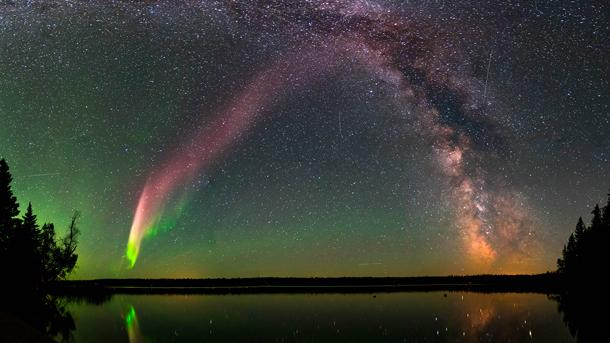The mysterious aurora known as ‘Steve,’ explained
A composite of images captures "Steve" (Strong Thermal Emission Velocity Enhancement) over Manitoba, Canada.
Thanks to collaboration between citizen scientists and astronomers, a strange phenomenon in the night sky, dubbed “Steve,” has finally been explained.
In 2017, a glowing purple-and-green ribbon across the heavens mystified sky-watchers because it showed up much further south than the famous northern lights, or aurora borealis. These observers decided to call it “Steve,” echoing the woodland creatures in the children’s movie "Over the Hedge."
For a time, nobody knew what Steve actually was or what caused it. Now there’s a bona fide scientific explanation, according to NASA space scientist Liz MacDonald.
“Steve is a new type of aurora structure that can be seen in the northern or southern sky further south than the usual aurora,” MacDonald explains. “What we now know from the satellite observations is that this structure is associated with a very strong flow of the charged particles in the upper atmosphere that you can actually see when you're looking at Steve. That signature from the satellite observations — this very narrow, long, purple arc — is actually something that scientists know and have studied for a long time. It's something called a sub-auroral ion drift.”
To give Steve a more scientific name, a colleague of MacDonald suggested a “bacronym:" Strong Thermal Emission Velocity Enhancement. “All of those terms correspond to what's seen in the satellite observations and to Steve actually being the visible signature of this sub-auroral ion drift,” MacDonald says. Plus, Steve gets to keep his name.
Steve differs from normal aurora light, which is produced by charged particles “raining down on the upper atmosphere and exciting the molecules in the upper atmosphere as they come down the magnetic field lines,” MacDonald explains.
The light associated with Steve, on the other hand, is produced by a strong flow of charged particles “kind of being dragged across the neutral particles in the atmosphere and heating them up,” MacDonald says. “It’s more like a frictional heating mechanism that is producing some light and that light is in different wavelengths than what you normally see in the aurora.”
To determine Steve's true identity, scientists combined traditional observations from satellites with the University of Calgary's ground-based array of cameras that study the aurora and “really great citizen science observations of this event,” MacDonald explains.
MacDonald is the founder of Aurorasaurus, which collects observations from amateur photographers worldwide.
“Aurorasaurus,” she says, “served as the bridge between the traditional science community and a very vibrant, very enthusiastic and skilled community of aurora chasers worldwide.”
MacDonald believes giving the phenomenon the whimsical name "Steve," an invention of a group called Alberta Aurora Chasers, spurred interest in finding an explanation for it.
“[The name] has been really helpful in encouraging people to appreciate the science and to appreciate the citizen science, as well,” MacDonald says. “We have a lot of jargon in our field. Sub-auroral ion drift is a mouthful of jargon. This paper and this discovery show that we don't need the jargon and that it's possible to have a fun name, but also have a scientific name, and that people can really contribute to helping us understand the world.”
This article is based on an interview that aired on PRI’s Living on Earth with Steve Curwood.
